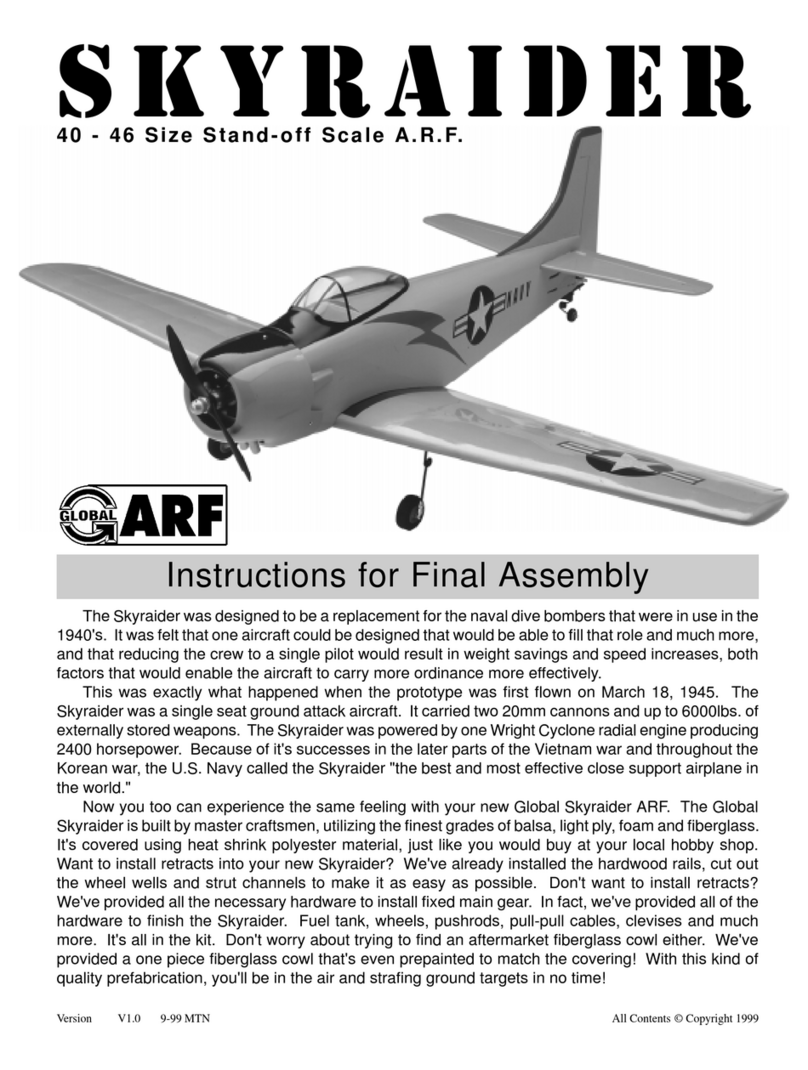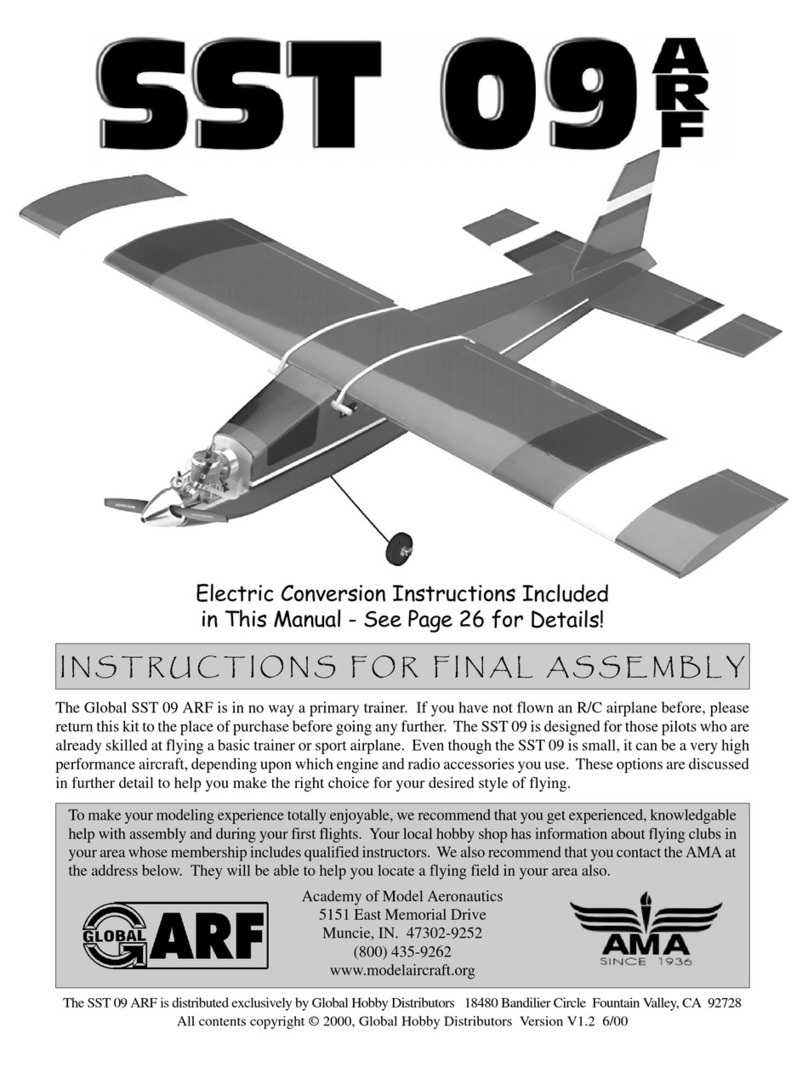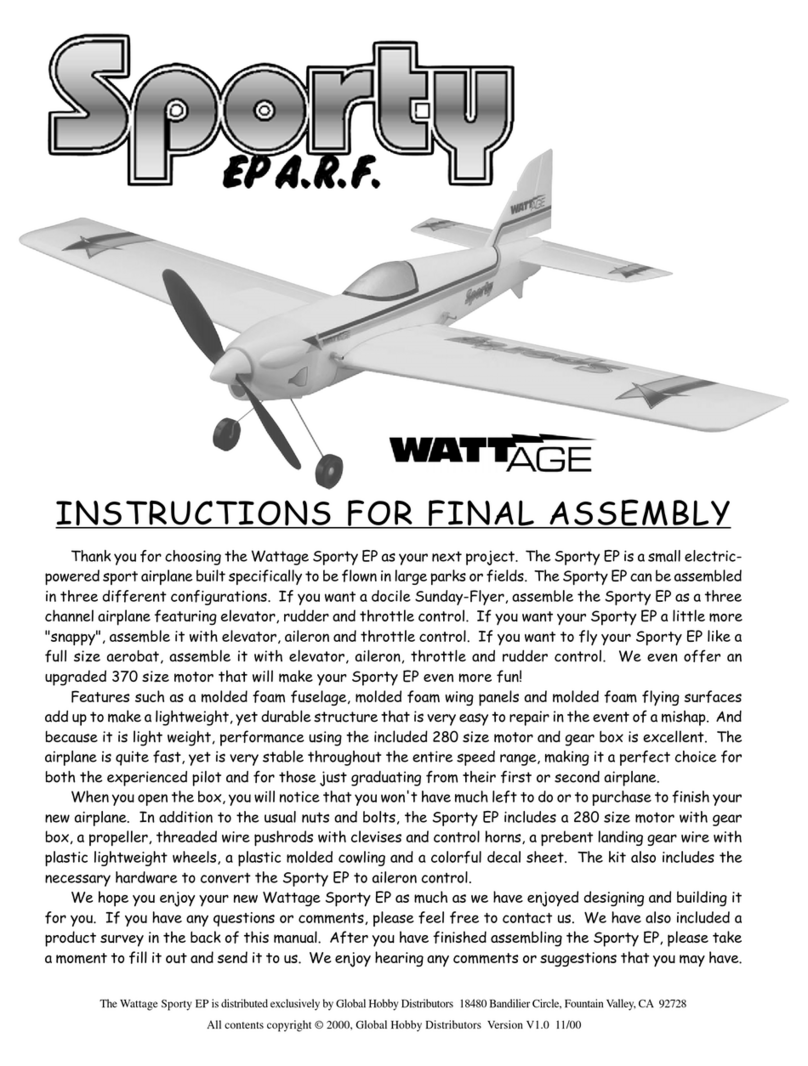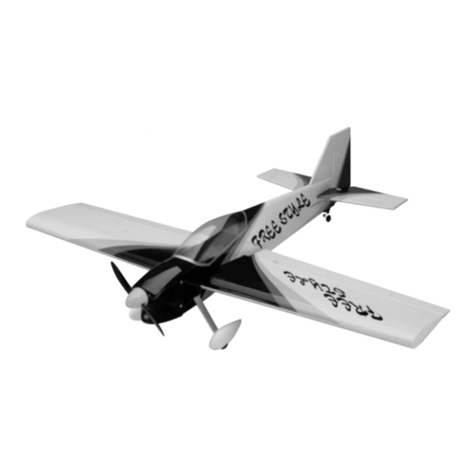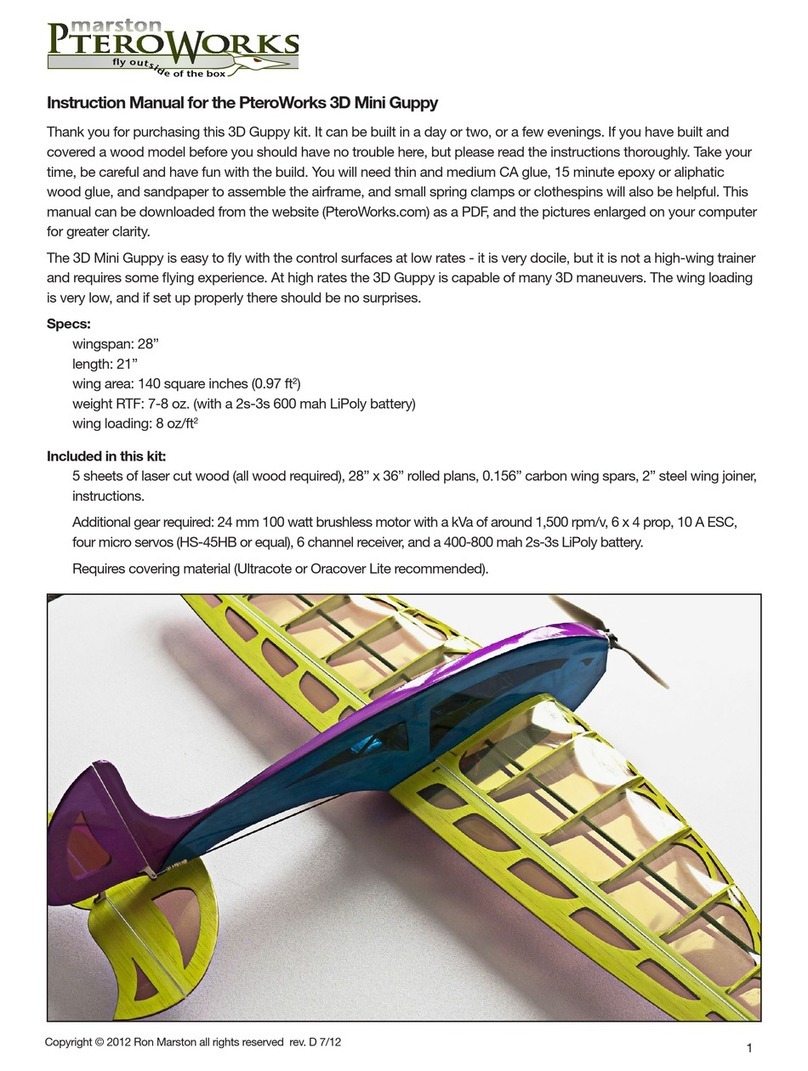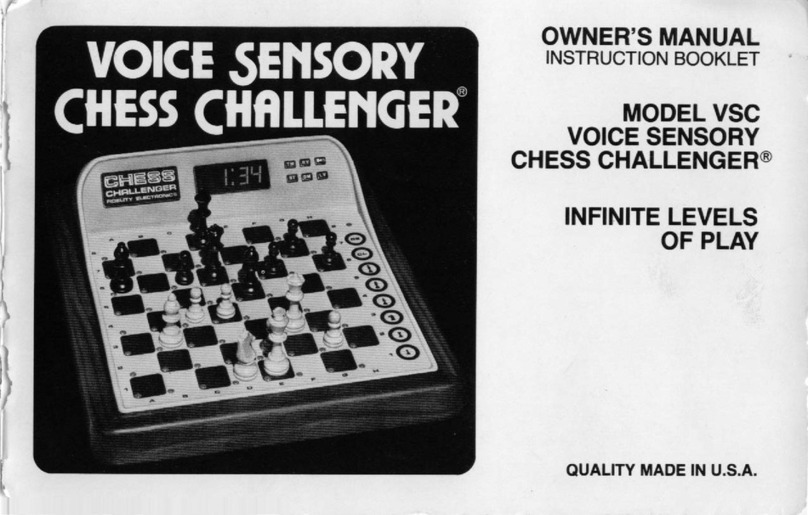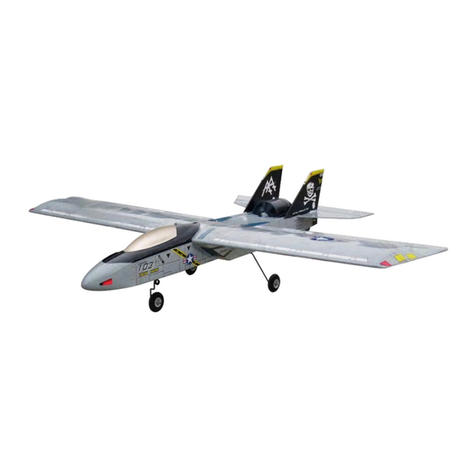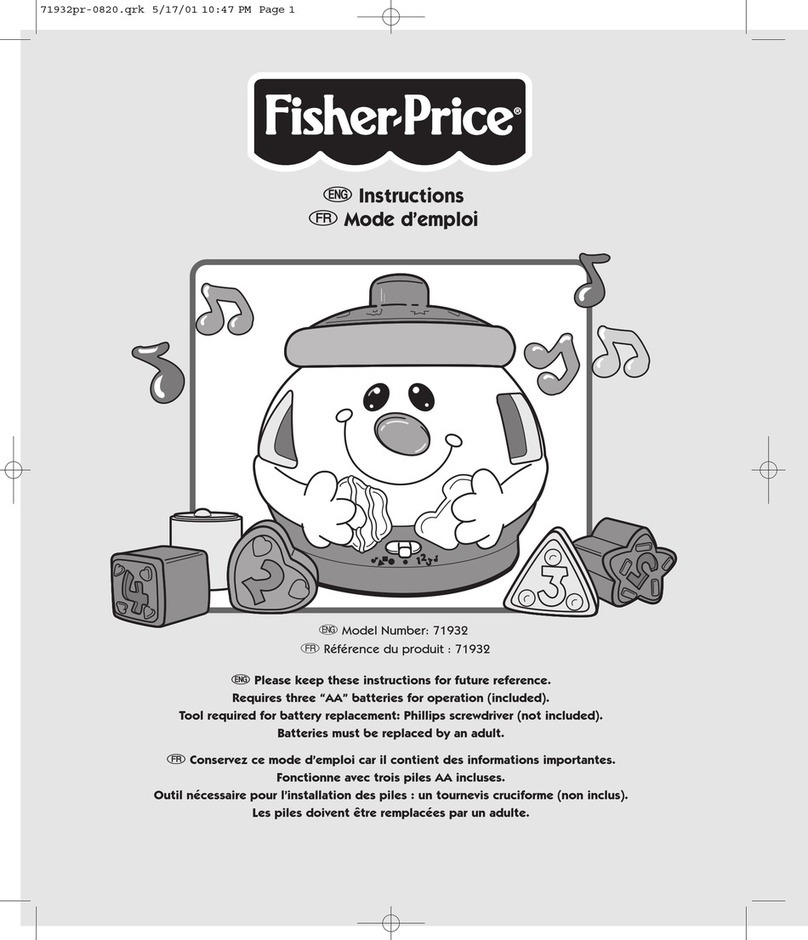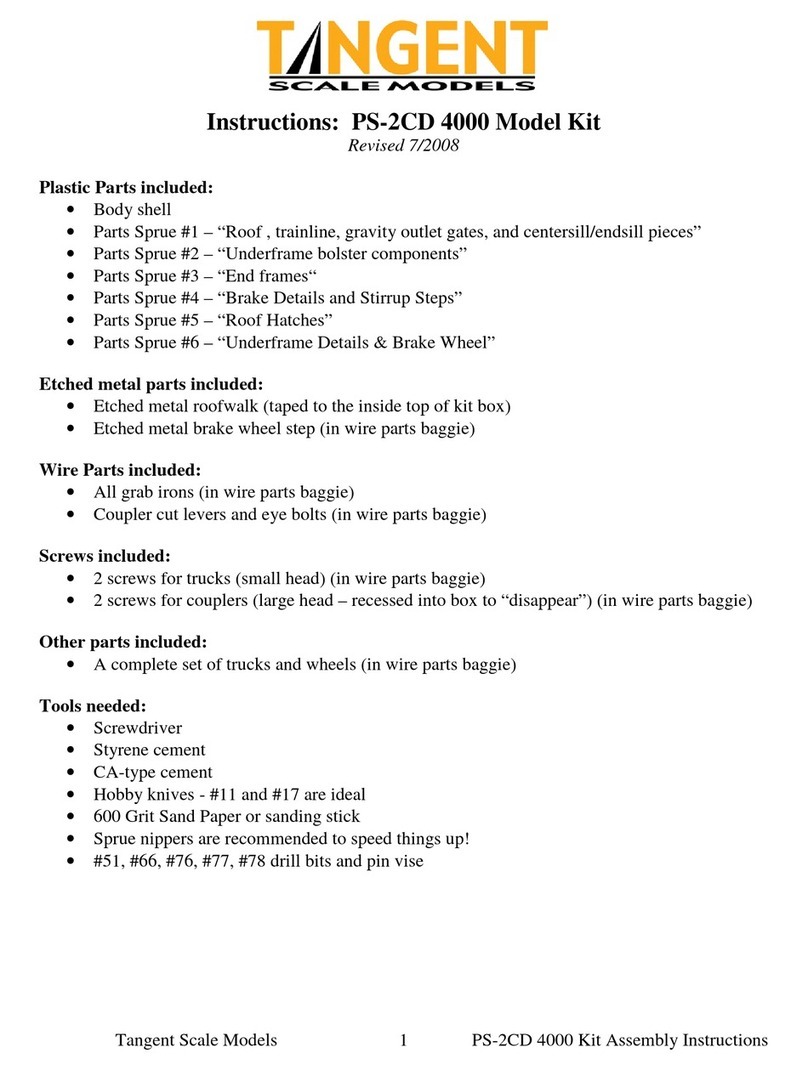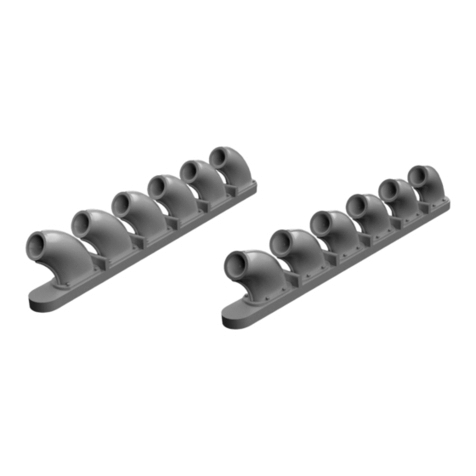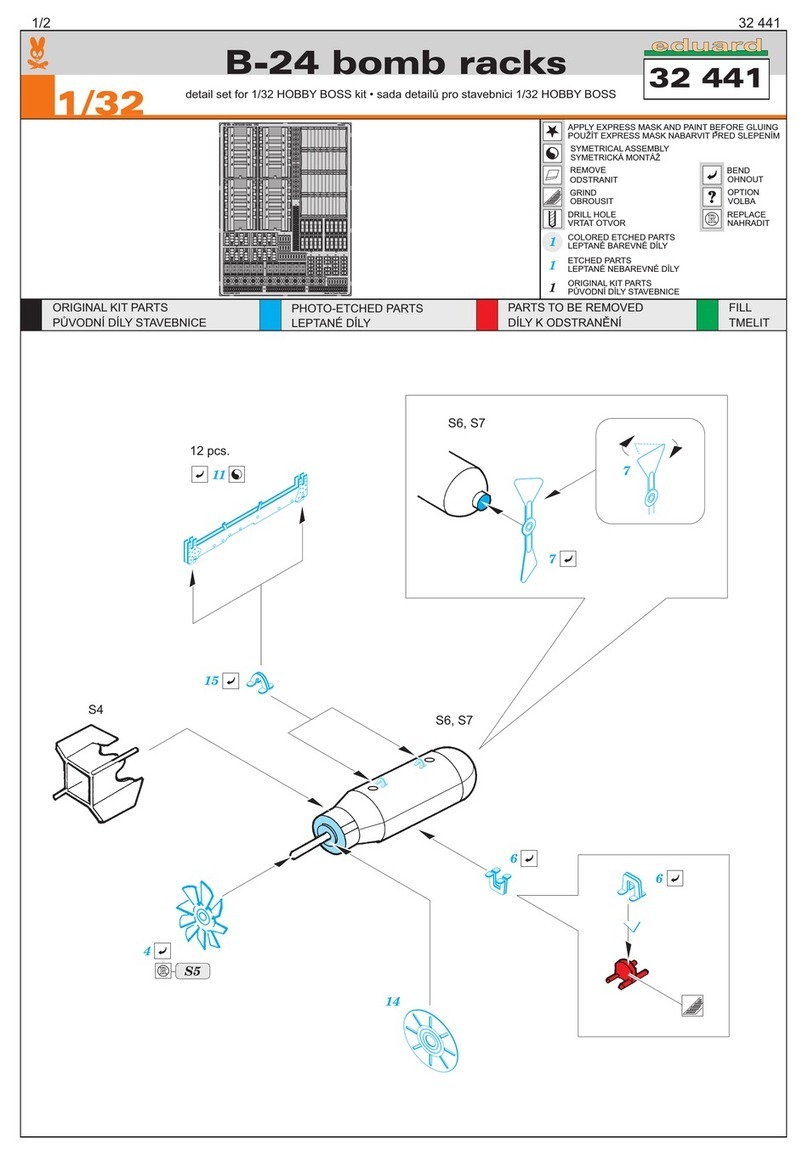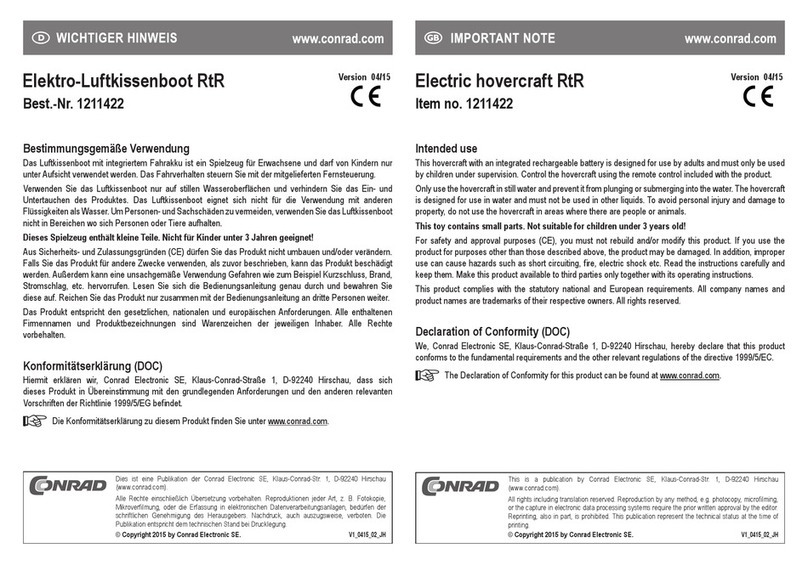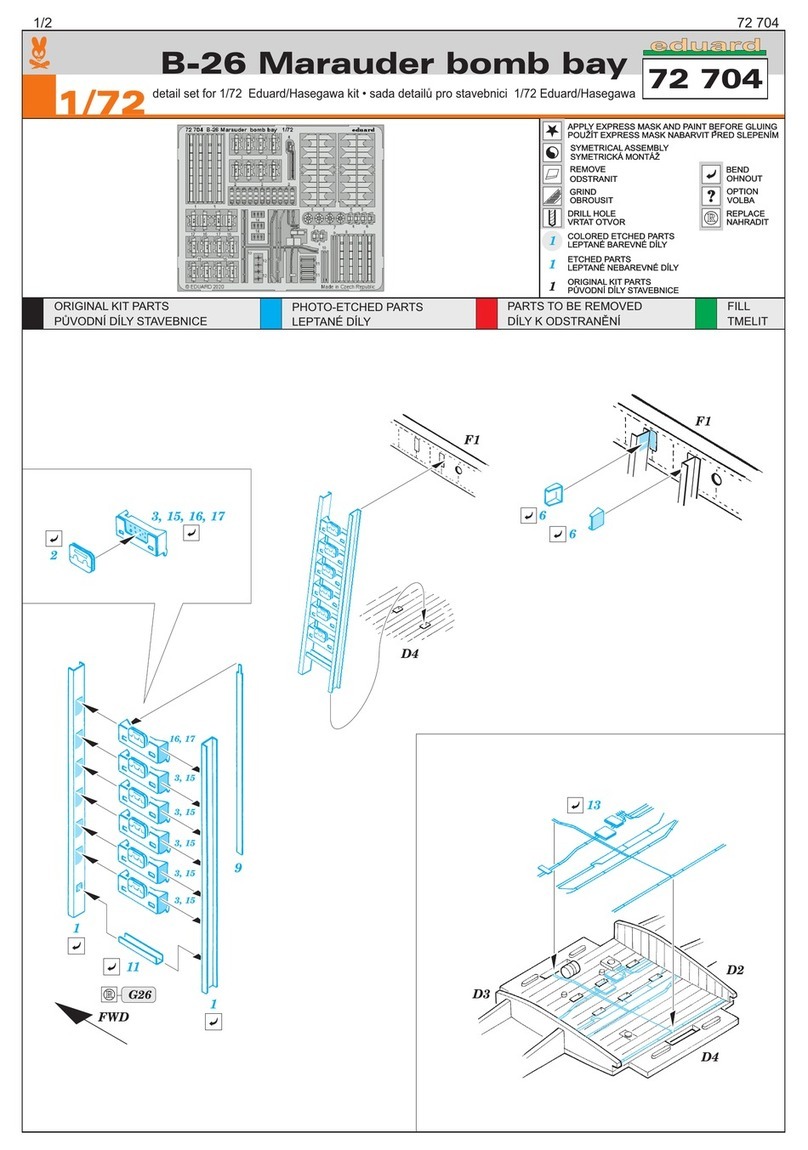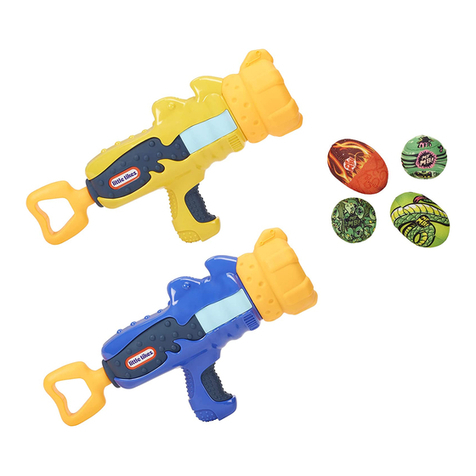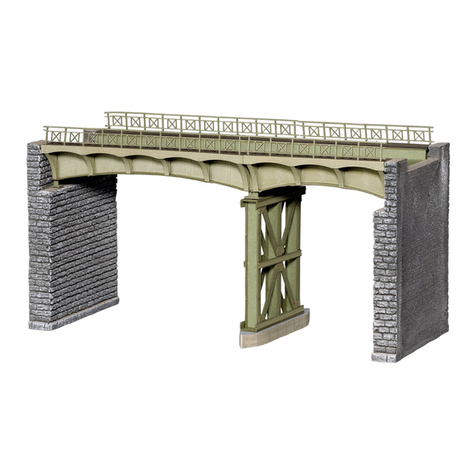Global Hobby Ryan STA User manual

1
Ryan STA ARF Specifications:
●Wing Span: 57 Inches (1447mm)
●Wing Area: 488 Square Inches (31.5dm2)
●Length: 41 Inches (1041mm)
●Weight RTF: 60-68 Ounces (1700-1930gr)
●Wing Loading: 17 - 20 Ounces Per Square Foot (54 -61gr/dm2)
●Functions: Ailerons, Elevator, Rudder and Throttle
●Engine Required: .28 - .46 Two-Stroke or .52 Four-Stroke
●Radio Required: 4 Channel or More w/5 Standard Servos
INSTRUCTIONS FOR FINAL ASSEMBLY
The Sportsman Aviation Ryan STA ARF is distributed
exclusively by Global Hobby Distributors
18480 Bandilier Circle, Fountain Valley, CA 92708
All contents copyright © 2004, Global Hobby
Distributors Version V1.0 February 2005
✦✦
✦✦
✦IMPORTANT✦✦
✦✦
✦The Sportsman Aviation Ryan STAARF is not intended for inexperienced pilots. It is not a trainer. If you are not
comfortable flying low wing sport aircraft, we strongly suggest returning the airplane (brand new, in the box with all original
packaging and your dated sales receipt) to the place of purchase.
Kit Product Number 127598
The Ryan STA is a classic aircraft known for it great handling when modeled. The Sportsman Aviation Ryan STA ARF, finished in YPT-16 military
version colors combines all the classic looks with a very easy to assemble and fly model airplane.
In full scale, it's a low-wing monoplane of mixed construction; a metal fuselage, wooden wing spars with fabric covering and external wire bracing.
The Ryan STA/YPT-16 has tandem open cockpits and was used by the Army Air Corps for primary training. It was the first monoplane acquired
by the Army as a primary trainer. From 1940 to 1942, the Army Air Corps bought nearly 1,200 more similar Ryan trainers as PT-20s, PT-21s, and PT-22s.
We know you'll enjoy owning and flying this historical and beautiful aircraft.
FULL-SCALE SPECIFICATIONS:
Span: 30 ft.
Length: 21 ft. 6 in.
Height: 10 ft. 1 in.
Weight: 1,600 lbs. loaded
Engine: Menasco L-365 engine/125 hp.
Maximum speed: 128 mph.
Cruising speed: 118 mph.
Range: 350 miles
Service Ceiling: 10,000 ft.

2
TABLE OF CONTENTS
This R/C airplane is not a toy! If misused or abused, it can cause serious bodily injury and/or damage to property. Fly only in open
areas and preferably at a dedicated R/C flying site. We suggest having a qualified instructor carefully inspect your airplane before
its first flight. Please carefully read and follow all instructions included with this airplane, your radio control system and any other
components purchased separately.
OUR GUARANTEE
Sportsman Aviation guarantees this kit to be free from defects in both material and workmanship at the date of purchase. This does not cover any
component parts damaged by use, misuse or modification. In no case shall Sportsman Aviation's liability exceed the original cost of the
purchased kit.
In that Sportsman Aviation has no control over the final assembly or material used for final assembly, no liability shall be assumed for any damage
resulting from the use by the user of the final user-assembled product. By the act of using the final user-assembled product, the user accepts all
resulting liability.
FOR YOUR INFORMATION
To make your modeling experience totally enjoyable, we recommend that you get experienced, knowledgeable help with assembly and during
your first flights. Your local hobby shop has information about flying clubs in your area whose membership includes qualified instructors. If there
is no hobby shop in your area, we recommend that you contact the AMA at the address below. They will be able to help you locate a flying field
near you.
Academy of Model Aeronautics
5151 East Memorial Drive
Muncie IN 47302-9252
(800) 435-9262
www.modelaircraft.org
SAFETY WARNING
Safety Warning ...................................................................................... 2
Introduction ............................................................................................ 3
Customer Service Information .............................................................. 3
Section 1: Our Recommendations ....................................................... 4
Section 2: Tools and Supplies Required ............................................. 5
Section 3: A Note About Covering ....................................................... 5
Section 4: Kit Contents ........................................................................ 6
Section 5: Wing Assembly ................................................................... 7
Section 6: Stabilizer Installation ......................................................... 10
Section 7: Control Surface Hinging ................................................... 13
Section 8: Tail Wheel Installation ....................................................... 15
Section 9: Landing Gear Installation ................................................. 17
Section 10: Engine Installation .......................................................... 19
Section 11: Throttle Control System Installation ............................... 20
Section 12: Fuel Tank Assembly and Installation .............................. 23
Section 13: Elevator Control System Installation .............................. 24
Section 14: Rudder Control System Installation ............................... 27
Section 15: Aileron Control System Installation ................................ 30
Section 16: Cowling Installation ......................................................... 32
Section 17: Wing Struts Installation ................................................... 33
Section 18: Final Assembly ................................................................ 35
Section 19: Balancing the Ryan STA ARF ........................................ 37
Section 20: Control Throws ............................................................... 37
Section 21: Preflight Check and Safety ............................................. 38
Section 22: Replacement Parts ......................................................... 38
Product Evaluation Sheet ................................................................... 39
Check out our website for more information on
this and other exciting Sportsman Aviation products!
http://www.globalhobby.com

3
Thank you for purchasing the Sportsman Aviation Ryan STA ARF. Before completing the final assembly of your new
airplane, please carefully read through this instruction manual in its entirety. Doing so will ensure your success the first
time around!
SPORTSMAN AVIATION RYAN STA ARF FEATURES
●Prebuilt from High-Quality Balsa and Light Plywood
●Precovered with Real Iron-On, Heat-Shrink Covering Material
●Scale Realism and Great Flight Characteristics
●Prebent Wire Main Landing Gear with Prepainted Semi-Scale Fairings and Steerable Tail Wheel
●Prepainted Molded Cowling, Cockpit Inserts, Fuselage Fairing and Windscreens
●Dual Aileron Servos, Pull-Pull Rudder Cables and Split Elevator Pushrod Assembly for Solid Control Response
●Includes a High-Quality Hardware Package with Adjustable Engine Mounting Beams
●Fast and Easy Assembly - Over 80 High-Resolution Digital Photos and Drawings to Guide You
This instruction manual is designed to guide you through the entire assembly process of your new airplane in the least amount of
time possible. Along the way you'll learn how to properly assemble your new airplane and also learn tips that will help you in the
future. We have listed some of our recommendations below. Please read through them before beginning assembly.
●Please read through each step before beginning assembly.
You should find the layout very complete and straightforward.
Our goal is to guide you through assembly without any of the
headaches and hassles that you might expect.
●There are check boxes next to each procedure. After you
complete a procedure, check off the box. This will help prevent
you from losing your place.
●Cover your work table with brown paper or a soft cloth, both
to protect the table and to protect the parts.
●Keep a couple of small bowls or jars handy to put the small
parts in after you open the accessory bags.
●We're all excited to get a new airplane in the air, but take your
time. This will ensure you build a straight, strong and great
flying airplane.
●If you come across this symbol ☞, it means that this is an
important point or an assembly hint.
If you should find a part missing or damaged, or have any questions about assembly, please contact us at the address below:
To enable us to better serve your needs, please include your email address with any correspondence you send to us. Your email
address will be added to our Customer Service Database so you will automatically receive free updates and tech notices for your
particular product. You will also receive repair status updates (if applicable) and other important information about your product
as it becomes available.
IMPORTANT INFORMATION ABOUT YOUR EMAIL ADDRESS
INTRODUCTION
CHECK IT OUT! We urge you to come check out our website at http://globalservices.globalhobby.com. There you will find public message
boards frequented by other Sportsman Aviation product owners and the our support staff. This is a great place to learn about new products,
get help and suggestions for your current products or just simply hang out and chat with people that share your same interests.
Global Hobby Distributors will not disclose the information it collects to outside parties. Global Hobby Distributors does not sell,
trade, or rent your personal information to others . Your privacy is important to us.
CUSTOMER SERVICE INFORMATION
In the USA:
Global Services
18480 Bandilier Circle
Fountain Valley, CA 92708
Phone: (714) 963-0329
Fax: (714) 964-6236
Email: service@globalhobby.net

4
This section describes our recommendations to help you in deciding which types of accessories to purchase for your new
Sportsman Aviation Ryan STA ARF. Please read through this entire section very carefully. We have provided you with tips
and recommendations that, if followed, will result in a great flying airplane. Failure to follow our recommendations may
result in a poor flying airplane.
SECTION 1: OUR RECOMMENDATIONS
What Engine Should I Use?
The airplane is designed to be flown with a .28-.46 size two-stroke engine. With a powerful .28 size engine, the airplane will be
very light and fly at a slower, more scale-like speed and be able to perform basic aerobatics like its
full-scale counterpart. If you use a .46 size engine, the airplane with will fly faster and have good vertical
performance, although it will be heavier and have a higher wing loading. If your flying field is at a
high altitude, we strongly suggest using an engine in the larger size range.
The engine is mounted on its side and adjustable engine mounting beams are included to
mount your engine. If you're using a .28 size engine, you should be able to use your
engine's stock muffler without any problem, although you will need a muffler extension to
clear the bottom of the firewall. If you're using a .40 or .46 size engine, we suggest using a
Pitt's style muffler.
If you prefer to use a four-stroke engine, we recommend using a .52 size engine. This size engine will give the
airplane great performance with the scale sound of a four-stroke engine. We don't suggest using a larger
four-stroke engine. A larger engine may not physically fit on the firewall, nor inside the cowling.
The engine is mounted sideways and adjustable engine mounting beams are included to mount your
engine. Since the muffler pipe on most four-stroke engines is adjustable, no aftermarket muffler
should be necessary.
What Radio System and Servos Should I Use?
The airplane can be flown with a basic four-channel radio control system. Ideally, the
transmitter should feature dual rates, servo reversing and end point adjustments. Most
newer radio control systems have these features and more.
Regarding servos, you will need to use five standard with a minimum of 36oz/in of
torque for the flight control surfaces and the throttle. The ailerons use separate servos,
so you will need a Y-Harness to connect both aileron servos together.
What Else Do I Need?
There really isn't too much else that you'll need to finish the airplane. For more scale realism, a pilot
bust would be a good choice. You'll also need typical modeling supplies, such as foam rubber to
protect your receiver and battery, and fuel tubing.
QTY. 1 210630 Magnum XL .28ARNV Two-Stroke Engine
QTY. 1 280151 Magnum Muffler Extension
QTY. 1 608360 APC 9 x 6 Propeller
QTY. 5 444104 Cirrus CS-36 Standard Servos
QTY. 2 444713 Cirrus 12" Servo Extensions
QTY. 1 444728 Cirrus Y-Harness
✦✦
✦✦
✦IMPORTANT✦✦
✦✦
✦The part number for the Cirrus Servos is compatible with all name-brand radio control systems. The Cirrus servo extensions
and Y-Harness are compatible with Hitec and JR radio control systems. These items are also available with connectors that are compatible
with Futaba and Airtronics radio control systems.
QTY. 1 115559 Thunderbolt # 3 Performance Glow Plug
QTY. 1 115923 Global XX Silicone Fuel Tubing
QTY. 1 868638 Dubro 1/4" Protective Foam Rubber
QTY. 1 867903 Dubro 3/8" Heat-Shrink Tubing
Here's a List of What We Used to Finish Our Ryan STA ARF

5
The covering material used on the Sportsman Aviation Ryan STA ARF is real iron-on, heat-shrink covering material. It is
possible with heat and humidity changes that the covering on your airplane may wrinkle or sag. This trait is inherent in all
types of heat-shrink material. To remove any wrinkles that might be visible you will need to use a heat-sealing covering iron.
Follow this simple procedure to remove the wrinkles:
❑Plug in and turn on the sealing iron to the medium-high temperature setting. Allow the sealing iron to heat up for approximately
5 - 7 minutes.
❑After the sealing iron has reached temperature, lightly apply the sealing iron to the wrinkled section of the covering. Move the
sealing iron slowly over the wrinkled section until the covering tightens and the wrinkles disappear.
✦✦
✦✦
✦IMPORTANT✦✦
✦✦
✦You will notice that the color of the covering will darken when it is heated. When the covering cools back down,
it will return to its normal color.
☞If the color layer smears from any of the seams the temperature of the sealing iron is too hot. Turn the temperature dial down
and wait about 5 minutes for the sealing iron to adjust to the lower temperature. You can remove any excess color streaks using a
paper towel soaked with a small quantity of Acetone.
We do not suggest storing your airplane in an extremely hot environment (like the back of your car in direct sunlight)
for any length of time. The extreme heat could distort the molded parts and/or cause the covering material to wrinkle and possibly
damage the fragile components of the radio control system.
✦✦
✦✦
✦WARNING✦✦
✦✦
✦The fiberglass cowling, plastic landing gear fairings and other assorted plastic parts on your Ryan STA ARF are
painted. Do not use any harsh chemical cleaners, such as Acetone, to clean the painted surfaces. Use of rubbing alcohol is okay
and will not damage the paint.
❑Kwik Bond Thin C/A # 887500
❑Kwik Bond Thick C/A # 887510
❑Kwik Bond 5 Minute Epoxy # 887560
❑Kwik Bond 30 Minute Epoxy # 887565
❑Kwik Bond C/A Debonder # 887545
❑Pacer Formula 560 Canopy Glue # 339176
❑Wilhold Silicon Sealant # 335407
❑Pacer Z-42 Blue Threadlocker # 339162
❑#1 & #2 Phillips Head Screwdrivers
❑.050, 2.5mm & 3mm Hex Wrenches
❑Wire Cutters
❑Needle Nose Pliers
❑Magnum Z-Bend Pliers # 237473
❑Adjustable Wrench
❑Excel Modeling Knife # 692801
❑Scissors
❑Electric Drill
❑Assorted Drill Bits
❑Ernst Airplane Stand # 223977
❑Ruler
❑Pencil
❑Dubro T-Pins # 567677
❑Rotary Tool w/Cutting Disc & Sanding Drum
❑Builder's Triangle
❑220 Grit Sandpaper w/Sanding Block
❑Masking Tape
❑Paper Towels
❑Waxed Paper
❑Rubbing Alcohol
❑NHP Epoxy Mixing Sticks # 864204
❑NHP Epoxy Mixing Cups # 864205
❑Global Heat Gun # 360920
❑Global Heat-Sealing Iron # 360900
SECTION 2: TOOLS AND SUPPLIES REQUIRED
The tools and supplies listed below will be necessary to finish the assembly of your new Sportsman Aviation Ryan STA ARF. We
suggest having these items on hand before beginning assembly.
SECTION 3: A NOTE ABOUT COVERING
PRO TIP

6
We have organized the parts as they come out of the box for easier identification during assembly. Before you begin assembly,
group the parts as we list them below. This will ensure that you have all of the parts before you begin assembly and it will also help
you become familiar with each part.
If you find any parts missing or damaged, please contact us as soon as possible,
using the Customer Service Information on page # 3.
SECTION 4: KIT CONTENTS
AIRFRAME ASSEMBLIES
❑(1) Fuselage
❑(1) Right Wing Panel w/Aileron
❑(1) Left Wing Panel w/Aileron
❑(1) Horizontal Stabilizer w/Elevator Halves
❑(1) Vertical Stabilizer w/Rudder
❑(1) Stranded Steel Pull-Pull Cable
❑(2) Plywood Blocks
❑(1) M4 x 50mm Threaded Rod
❑(2) Nylon Adjustable Control Horns
❑(4) Threaded Couplers
❑(4) Nylon Clevises
❑(4) Crimp Collets
❑(2) M4 Flat Washers
❑(2) M4 Hex Nuts
❑(3) C/A-Style Hinges
RUDDER CONTROL SYSTEM
Continued On Next Page
☛☛
☛☛
☛
LANDING GEAR ASSEMBLY
❑(2) Prebent Landing Gear Struts
❑(2) Molded Landing Gear Fairings
❑(2) Main Gear Wheels
❑(8) Landing Gear Straps
❑(2) Wheel Collars w/Grub Screws
❑(8) M2 x 8mm Wood Screws
❑(16) M3 x 12mm Wood Screws
AILERON CONTROL SYSTEM
❑(2) 3-1/4" Threaded Wires w/Z-Bends
❑(2) Nylon Control Horns
❑(2) Nylon Control Horn Backplates
❑(2) Nylon Clevises
❑(4) M2 x 25mm Machine Screws
❑(6) C/A-Style Hinges
ELEVATOR CONTROL SYSTEM
❑(1) Split Pushrod Assembly
❑(2) Nylon Control Horns
❑(2) Nylon Control Horn Backplates
❑(2) Nylon Clevises
❑(4) M2 x 12mm Machine Screws
❑(6) C/A-Style Hinges
ENGINE MOUNT ASSEMBLY
❑(2) Engine Mounting Beams
❑(4) M4 x 18mm Socket-Cap Screws
❑(4) M3 x 25mm Socket-Cap Screws
❑(4) M4 Flat Washers
❑(4) M3 Flat Washers
❑(4) M3 Split Washers
❑(4) M3 Hex Nuts
❑(1) Tail Wheel Bracket Assembly w/Tail Wheel & Wheel Collar
❑(1) M2 x 30mm Metal Pin
❑(3) M3 x 8mm Wood Screws
TAIL WHEEL ASSEMBLY
❑(1) 20" Plain Wire w/Z-Bend
❑(1) Adjustable Pushrod Connector
THROTTLE CONTROL SYSTEM
❑(1) 280cc Fuel Tank
❑(1) Nylon Fuel Tank Cap
❑(1) Rubber Stopper
❑(1) Nylon Stopper Backplate
❑(1) Silicone Fuel Tubing
❑(1) Fuel Pick-Up "Clunk"
❑(1) Nylon Straight Fuel Pick-Up Tube
❑(2) Nylon 90º Vent Tubes
❑(1) M3 x 22mm Self-Tapping Screw
FUEL TANK ASSEMBLY
❑(2) Wing Struts
❑(4) Molded Wing Strut Fairings
❑(8) M2 x 8mm Wood Screws
❑(1) Rigging Cable
WING STRUT ASSEMBLIES

7
MISCELLANEOUS FUSELAGE PARTS
❑(1) Molded Cowling
❑(1) Spinner Assembly w/Backplate & Screws
❑(1) 10 x 6 Composite Propeller (for .40 & .46 Size Engines Only)
❑(2) Molded Windscreens
❑(1) Molded Fuselage Fairing
❑(4) M3 x 10mm Flange-Head Wood Screws
❑(1) Black Striping Tape
❑(1) Decal Set
❑Kwik Bond 30 Minute Epoxy
❑# 1 Phillips Head Screwdriver
❑Excel Modeling Knife
❑Electric Drill
❑1/16" Drill Bit
❑Ruler
❑Pencil
❑(1) Right Wing Panel w/Aileron
❑(1) Left Wing Panel w/Aileron
❑(1) Plywood Wing Joiner
❑220 Grit Sandpaper w/Sanding Block
❑Masking Tape
❑Paper Towels
❑Rubbing Alcohol
❑NHP Epoxy Mixing Sticks
❑NHP Epoxy Mixing Cups
❑Global Heat Gun
YOU'LL NEED THE FOLLOWING PARTS FROM THE KIT:
YOU'LL NEED THE FOLLOWING TOOLS AND SUPPLIES:
SECTION 5: WING ASSEMBLY
STEP 1: INSTALLING THE AILERON SERVOS
❑Install the rubber grommets and brass collets onto one aileron servo,
making sure to install the collets with the flanges toward the bottom of
the servo.
❑Plug one 12" servo extension onto the aileron servo lead.
❑To prevent the plugs from pulling apart during assembly, or worse,
during flight, secure the plugs together, using a short piece of 3/8"
diameter heat-shrink tubing. Use a heat gun to shrink the tubing.
Continued On Next Page
☛☛
☛☛
☛
❑Remove the aileron from the wing and set it aside. Discard the
temporary hinges. They won't be used.
❑Working with one wing panel for now, pull the servo extension lead
through the wing panel, using the factory-installed length of string.
☞Tie the end of the string to the servo extension plug at the servo
mounting hatch, then pull the string from the other end to guide the
servo extension lead out through the top of the wing panel.
❑(1) Plywood Wing Joiner
❑(1) M4 x 20mm Socket-Cap Screw
❑(1) M4 Flat Washer
MISCELLANEOUS WING PARTS
A complete replacement parts listing, along
with part numbers for ordering convenience,
can be found on page # 38.

8
❑Set the servo into place, making sure that the servo output shaft is
toward the root edge of the wing panel.
❑Install the aileron servo, making sure to drill 1/16" diameter pilot holes
for the mounting screws.
❑Repeat the previous procedures to install the aileron servo into the second wing panel.
STEP 2: ALIGNING THE WING PANELS
❑Using a modeling knife, cut away and remove the excess covering
material that overlaps onto the root ribs of each wing panel, leaving
about 1/16" overlapped so it does not pull away.
✦✦
✦✦
✦IMPORTANT✦✦
✦✦
✦It's very important to the integrity of the wing
center-section joint that you remove as much covering material from
the root ribs as possible. Do not omit this procedure or the wing
center-section joint may fail during flight.
❑Use a ruler and a pencil to locate and draw a vertical centerline on
one side of the plywood wing joiner.
✦✦
✦✦
✦IMPORTANT✦✦
✦✦
✦The wing joiner is cut in the shape of a shallow "V." When you test-fit the wing joiner in the next procedure,
make sure that this "V" shape is toward the top of the wing panels. This will ensure that the wing panels fit together properly with
the correct amount of dihedral.
❑Test-fit the wing joiner into each wing panel. It should slide easily
into each wing panel, up to the centerline you drew.
✦✦
✦✦
✦IMPORTANT✦✦
✦✦
✦When the wing joiner is installed, it should not fit
tightly into the wing panels. It should actually be slightly loose. This
will ensure that when you glue the wing joiner into place that epoxy
can get into the joints between the wing joiner and the joiner box.
This will ensure the strongest joint possible.
☞If the wing joiner does not fit properly, use 220 grit sandpaper
with a sanding block to lightly sand the wing joiner, until you are satisfied
with the fit.
Continued On Next Page
☛☛
☛☛
☛

9
❑Carefully slide both wing panels together with the wing joiner
temporarily installed (without using glue).
❑Apply a strip of masking tape to the top and bottom edges of the root
rib on each wing panel.
☞The masking tape will prevent excess epoxy from getting onto the
wing panels when you join them.
STEP 3: JOINING THE WING PANELS
❑Mix a generous amount of 30 minute epoxy. Working with only one wing panel for now, apply a thin layer of epoxy inside the wing
joiner box and to only half of the wing joiner. Make sure to cover the top and bottom, as well as the sides, and use enough epoxy to
fill any gaps.
✦✦
✦✦
✦WARNING✦✦
✦✦
✦Use only 30 or 45 minute epoxy to install the wing joiner and to join the wing panels together. Do not use 5
minute epoxy. It is not strong enough. If you use 5 minute epoxy, the wing will fail during flight.
❑Slide the wing joiner into the wing panel up to the centerline mark. Quickly remove any excess epoxy, using a paper towel and
rubbing alcohol, and allow the epoxy to set up before proceeding.
❑After the epoxy has set up, test-fit both wing panels together again to double-check that they still fit together properly. Check the
leading and trailing edges, too. It's important that they be even with each other.
❑Mix a generous amount of 30 minute epoxy and apply a thin layer to the exposed half of the wing joiner, the inside of the wing
joiner box in the second wing panel, and the entire surface of BOTH root ribs. Make sure to use enough epoxy to fill any gaps.
✦✦
✦✦
✦IMPORTANT✦✦
✦✦
✦It is of the utmost importance to the integrity of the wing center-section joint that you apply a generous amount
of epoxy to both root ribs and the wing joiner. Not using enough epoxy can result in wing failure during flight.
❑Slide the two wing panels together and realign them. Quickly wipe away any excess epoxy, using a paper towel and rubbing
alcohol, and use pieces of masking tape to hold the two wing panels aligned until the epoxy fully cures.
❑While holding the two wing panels together firmly, make sure that the wing panels are lined up at both the leading and trailing
edges, then look carefully at the center-section joint: the wing panels should fit together tightly with few or no gaps in the joint.
✦✦
✦✦
✦IMPORTANT✦✦
✦✦
✦If the wing panels do not fit together properly, remove the wing joiner and use 220 grit sandpaper with a
sanding block to lightly sand the edges and tips of the wing joiner, until you are satisfied with the fit. Remember, when the wing
panels are pushed together, there should be few or no gaps in the center-section joint.
❑When satisfied with the fit and alignment, pull the wing panels apart and remove the wing joiner.
Continued On Next Page
☛☛
☛☛
☛

10
STEP 4: CHECKING THE WING CENTER-SECTION JOINT
❑Once the epoxy has fully cured, remove the masking tape and double-check the center-section joint. If any gaps are present,
mix a small quantity of 30 minute epoxy and carefully fill any remaining gaps.
✦✦
✦✦
✦IMPORTANT✦✦
✦✦
✦Do not omit this procedure. The wing panels should fit together tightly, but it's possible to have some small gaps
that appear after the epoxy has cured. To make the wing center-section joint as strong as possible, it's important to fill any gaps,
using 30 minute epoxy.
❑Kwik Bond 30 Minute Epoxy
❑3mm Hex Wrench
❑Excel Modeling Knife
❑Ernst Airplane Stand
❑Ruler
❑Pencil
❑Dubro T-Pins
❑(1) Fuselage
❑(1) Horizontal Stabilizer w/Elevator Halves
❑(1) Vertical Stabilizer w/Rudder
❑(1) M4 x 20mm Socket-Cap Screw
❑(1) M4 Flat Washer
❑Builder's Triangle
❑220 Grit Sandpaper w/Sanding Block
❑Masking Tape
❑Paper Towels
❑Rubbing Alcohol
❑NHP Epoxy Mixing Sticks
❑NHP Epoxy Mixing Cups
YOU'LL NEED THE FOLLOWING PARTS FROM THE KIT:
YOU'LL NEED THE FOLLOWING TOOLS AND SUPPLIES:
SECTION 6: STABILIZER INSTALLATION
STEP 1: MOUNTING THE WING
❑Place the wing into the wing saddle and push it forward completely,
making sure that the tab in the leading edge of the wing engages the
slot in the forward bulkhead.
❑Push the trailing edge down into place and align the hole in the wing
with the preinstalled blind nut in the wing mounting block inside the
fuselage.
❑Secure the wing into place, using one M4 x 20mm socket-cap screw
and one M4 flat washer. Be careful not to overtighten the screw. You
don't want to crush the wing.
STEP 2: ALIGNING THE HORIZONTAL STABILIZER
❑Slide the horizontal stabilizer into the mounting slot and center it by
carefully measuring out from each side of the fuselage to each end of
the stabilizer (at the trailing edge only for now). When the stabilizer is
centered, both measurements will be equal.
Continued On Next Page
☛☛
☛☛
☛

11
❑When you're satisfied that the stabilizer is centered at the trailing
edge, draw a mark on each side of the stabilizer (at the trailing edge)
where it meets the fuselage sides.
❑With the marks on the stabilizer lined up with the fuselage sides, hold
only the trailing edge of the stabilizer in position, using a T-Pin.
✦✦
✦✦
✦IMPORTANT✦✦
✦✦
✦The front of the stabilizer should be able to pivot from side to side and the back should stay firmly in place and
aligned. The trailing edge should not be allowed to move from side to side.
❑With the wing mounted to the fuselage, use a ruler to measure the
distance between the tips of the stabilizer and the tips of the wing. Pivot
the front of the stabilizer until both of these measurements are equal.
☞When both of these measurements are equal, you're assured that the stabilizer is square to the wing.
❑With the stabilizer held firmly in place, look from the front of the
airplane at both the wing and the stabilizer. When aligned properly, the
stabilizer should be parallel to the wing.
Continued On Next Page
☛☛
☛☛
☛
☞If the stabilizer is out of alignment, remove it and use 220 grit sandpaper with a sanding block to sand down the higher side of
the stabilizer mounting slot, then reinstall the stabilizer and check the alignment once more. Repeat this procedure until you are
satisfied with the alignment.
❑When you're satisfied that the stabilizer is square to the wing, use a
pencil to draw a couple of marks on each side of the front of the
stabilizer where it and the fuselage sides meet, then use a couple of
T-Pins to hold the stabilizer firmly in place and aligned.

12
STEP 3: MOUNTING THE HORIZONTAL STABILIZER
❑When satisfied with the alignment, use a pencil to draw a line on
each side of the stabilizer where it meets the fuselage sides. Do this on
both the top and the bottom.
❑Remove the stabilizer from the fuselage and carefully use a modeling
knife to cut away and remove the covering material from between the
lines you drew. Do this on both the top and the bottom.
❑To make it less messy during installation, apply masking tape to the
fuselage around the side of the mounting slot that the stabilizer will slide
into. Apply masking tape to the top and bottom of the corresponding
side of the stabilizer, too.
❑Partially slide the stabilizer into the mounting slot.
✦✦
✦✦
✦IMPORTANT✦✦
✦✦
✦Because the stabilizer has to slide into place through the fuselage, apply epoxy only to the stabilizer. This will
prevent the epoxy from spreading over the entire length of one half of the stabilizer when you slide it into place.
❑Mix and apply a generous amount of 30 minute epoxy to ONLY the top and bottom gluing surfaces of the stabilizer.
❑Push the stabilizer into place and realign it, double-checking all of your measurements once more before the epoxy sets up.
Quickly remove any excess epoxy and use T-Pins to hold the stabilizer in place and aligned until the epoxy has fully cured.
❑After the epoxy has fully cured, remove the masking tape and look closely at the glue joint. If there are any gaps between the
stabilizer and the fuselage, fill them using 30 minute epoxy for added strength. Again, before the epoxy sets up, remove any excess
epoxy, using a paper towel and rubbing alcohol.
STEP 4: ALIGNING THE VERTICAL STABILIZER
❑Push the vertical stabilizer down into its mounting slot. To align it properly, the trailing edge of the stabilizer should be even with
the back edge of the fuselage and the stabilizer should be pushed down firmly.
✦✦
✦✦
✦WARNING✦✦
✦✦
✦When cutting through the covering to remove it, cut with only enough pressure to cut through only the covering
itself. Cutting down into the balsa structure could weaken the stabilizer and cause it to fail during flight.
Continued On Next Page
☛☛
☛☛
☛

13
❑While holding the vertical stabilizer firmly in place, use a pencil to
draw a line on each side of the vertical stabilizer where it meets the top
of the fuselage.
STEP 5: MOUNTING THE VERTICAL STABILIZER
❑Remove the vertical stabilizer and use a modeling knife to carefully
cut away and remove the covering material from below the lines you
drew. Remove the covering material from the base of the vertical
stabilizer, too.
❑Push the vertical stabilizer down into place and realign it, double-
checking all of your measurements once more before the epoxy sets
up. Quickly remove the excess epoxy and use pieces of masking tape
or T-Pins to hold the vertical stabilizer in place until the epoxy has
fully cured.
✦✦
✦✦
✦IMPORTANT✦✦
✦✦
✦While the epoxy sets up, use a builder's triangle to
double-check that the vertical stabilizer is aligned 90º to the hori-
zontal stabilizer.
❑Kwik Bond Thin C/A
❑Kwik Bond C/A Debonder
❑Excel Modeling Knife
❑(15) C/A-Style Hinges
❑Ernst Airplane Stand
❑Dubro T-Pins
❑Paper Towels
YOU'LL NEED THE FOLLOWING PARTS FROM THE KIT:
YOU'LL NEED THE FOLLOWING TOOLS AND SUPPLIES:
SECTION 7: CONTROL SURFACE HINGING
✦✦
✦✦
✦WARNING✦✦
✦✦
✦When cutting through the covering to remove it, cut with only enough pressure to cut through only the covering
itself. Cutting down into the balsa structure could weaken the stabilizer and cause it to fail during flight.
❑Mix and apply a generous amount of 30 minute epoxy to the gluing surfaces of both the vertical stabilizer and the vertical
stabilizer mounting slot in the top of the fuselage.
Continued On Next Page
☛☛
☛☛
☛

14
STEP 1: HINGING THE AILERONS
✦✦
✦✦
✦Important Information About the C/A-Style Hinges Included with Your Ryan STA ARF✦✦
✦✦
✦
The Ryan STA ARF uses C/A-style hinges to hinge the control surfaces. These hinges are designed to be glued into place using
thin C/A. Do not glue these hinges into place using any other type of glue, such as thick C/A or epoxy. Use of any adhesive other
than thin C/A could result in failure of the hinges during flight.
For flutter-free control surfaces and crisp control response, it is imperative that the hinges be glued in properly. This is achieved
by having a tight hinge gap (no more than 1/32") and using plenty of thin C/A glue. Poor hinge installation can lead to control
surface flutter which can result in a catastrophic failure of the airframe.
❑Push two T-Pins through the center of three C/A-style aileron
hinges, as shown.
✦✦
✦✦
✦IMPORTANT✦✦
✦✦
✦The T-Pins will keep the hinges centered and square
to the leading edge while you are hinging the aileron.
❑Slide one hinge into each hinge slot in one aileron, making sure that
you push each hinge in up to the T-Pins. Don't glue the hinges into the
aileron yet though.
❑Push the aileron and its hinges into the hinge slots in the trailing edge of the corresponding side of the wing. Remove the T-Pins
and push the aileron into its final position. The aileron should be pushed firmly up against the trailing edge, so that there is a minimal
hinge gap (no more than 1/32"), and the curved tip of the aileron should match the curved tip of the wing. There should be a small
gap between the root end of the aileron and the wing.
❑While holding the aileron tight against the trailing edge of the wing
panel, pivot the aileron down about 45º and apply 5-6 drops of thin C/A
to the exposed area of each hinge. Turn the wing over and repeat for
the other side of the hinges.
☞Remove any C/A that may run down the hinge line, using C/A
Debonder.
❑Allow the C/A to dry for about 15 minutes, then pivot the aileron up
and down several times to free up the hinges.
After the C/A has fully cured, gently grasp the aileron and wing and pull on the aileron like you are trying to pull out
the hinges. The hinges should hold securely. If one or more hinges feels loose, apply more C/A to the hinge(s) and allow it to
completely cure.
❑Repeat the previous procedures to hinge the other aileron to the wing, making sure to check the integrity of the hinges
after the C/A fully cures. The last thing you want is for a hinge to come loose during flight.
PRO TIP
Continued On Next Page
☛☛
☛☛
☛

15
STEP 2: HINGING THE ELEVATOR HALVES AND THE RUDDER
❑Hinge the elevator halves, using the same techniques that you used
to hinge the ailerons. Each elevator half is hinged using three hinges.
When hinging the elevator halves, the tip of each elevator half should
be even with the tips of the horizontal stabilizer and there should not
be more than a 1/32" wide hinge gap.
✦✦
✦✦
✦IMPORTANT✦✦
✦✦
✦After allowing the C/A to fully cure, pull on the
elevator halves to check the integrity of the hinges. Apply more C/A
to the hinge(s) if necessary.
❑Hinge the rudder, using the same techniques that you used to hinge
the ailerons and the elevator halves. The rudder is hinged using three
hinges. When hinging the rudder, the top of the rudder should be even
with the top of the vertical stabilizer and there should not be more than
a 1/32" wide hinge gap.
✦✦
✦✦
✦IMPORTANT✦✦
✦✦
✦After allowing the C/A to fully cure, pull on the
rudder to check the integrity of the hinges. Apply more C/A to the
hinge(s) if necessary.
❑Kwik Bond Thick C/A
❑Kwik Bond C/A Debonder
❑#1 Phillips Head Screwdriver
❑.050 Hex Wrench
❑Electric Drill
❑1/16" & 5/64" Drill Bits
❑Ernst Airplane Stand
❑Ruler
❑Pencil
❑Rotary Tool w/Cutting Disc
❑Masking Tape
❑Paper Towels
YOU'LL NEED THE FOLLOWING PARTS FROM THE KIT:
YOU'LL NEED THE FOLLOWING TOOLS AND SUPPLIES:
SECTION 8: TAIL WHEEL INSTALLATION
❑(1) Tail Wheel Bracket Assembly w/Tail Wheel & Wheel Collar
❑(1) M2 x 30mm Metal Pin
❑(3) M3 x 8mm Wood Screws
STEP 1: INSTALLING THE TAIL WHEEL BRACKET
❑Double-check that the tiller arm is completely seated into the tail
wheel bracket (you may need to loosen the grub screw in the tiller arm
to adjust the fit), then use a rotary tool with a cutting disc attachment to
carefully cut the top of the tail wheel wire off flush with the top of the
tiller arm.
✦✦
✦✦
✦IMPORTANT✦✦
✦✦
✦The top of the tail wheel wire must be flush with the
top of the tiller arm to allow the tail wheel bracket to mount properly.
Continued On Next Page
☛☛
☛☛
☛

16
❑Place the tail wheel bracket onto the bottom of the fuselage. To
align the bracket, the pivot point of the tiller arm should be even with the
rudder hinge line and the bracket should be centered over the middle of
the fuselage.
❑When satisfied with the alignment, hold the bracket in place and use
a pencil to mark the locations of the three mounting screws onto
the fuselage.
❑Drill three 1/16" diameter pilot holes through the fuselage at the marks you drew, then secure the tail wheel bracket to the
fuselage, using three M3 x 8mm wood screws.
STEP 2: INSTALLING THE METAL STEERING PIN
❑Use a couple of pieces of masking tape, taped between the rudder and vertical stabilizer, to hold the rudder centered.
❑After the C/A has cured, loosen the grub screw in the side of the tiller arm. With the rudder still centered, rotate the tail wheel wire
until it is centered with the rudder. When satisfied with the alignment, tighten the grub screw firmly to lock the tiller arm and the tail
wheel wire into alignment.
❑Rotate the tiller arm so that it is centered over the bottom edge of the
rudder.
❑Use a pencil to draw a mark on the bottom edge of the rudder,
directly below the middle of the slot in the tiller arm.
❑Squeeze a small quantity of thick C/A down into the hole. Rotate the
tiller arm back into place and push the metal pin through the slot in the
tiller arm and into the hole in the rudder. Adjust the depth of the pin so
that there is 1/4" sticking above the tiller arm.
☞Any C/A that squeezes out of the hole can be removed promptly
using a paper towel soaked with a small quantity of C/A debonder.
❑Rotate the tiller arm out of the way. Using a drill with a 5/64" diameter
drill bit, drill a 3/4" deep hole into the bottom edge of the rudder at the
mark you drew, making sure that the hole is centered and that you drill it
straight down 90º to the tiller arm.

17
❑#1 & # 2 Phillips Head Screwdrivers
❑.050 Hex Wrench
❑Excel Modeling Knife
❑Electric Drill
❑1/16" Drill Bit
❑Ruler
❑Pencil
❑Rotary Tool w/Cutting Disc
❑220 Grit Sandpaper w/Sanding Block
❑Masking Tape
YOU'LL NEED THE FOLLOWING PARTS FROM THE KIT:
YOU'LL NEED THE FOLLOWING TOOLS AND SUPPLIES:
SECTION 9: LANDING GEAR INSTALLATION
❑(2) Prebent Landing Gear Struts
❑(2) Molded Landing Gear Fairings
❑(2) Main Gear Wheels
❑(8) Landing Gear Straps
❑(2) Wheel Collars w/Grub Screws
❑(8) M2 x 8mm Wood Screws
❑(16) M3 x 12mm Wood Screws
STEP 1: INSTALLING THE LANDING GEAR STRUTS
❑Working with one landing gear strut for now, insert the 90º bends in
the landing gear strut into the predrilled hole in each of the two landing
gear mounting slots in one half of the wing.
❑Push the landing gear strut wires firmly down into the slots.
☞The top of the strut wires should be nearly flush with the bottom
surface of the wing.
✦✦
✦✦
✦IMPORTANT✦✦
✦✦
✦You will need to cut a notch at the front of the rear
mounting slot to allow clearance for the landing gear strut wire.
❑Position four landing gear straps over the two landing gear strut
wires, as shown. The two inner landing gear straps should be located
near the end of the landing gear strut wires and the two outer landing
gear straps should be located 1" in from the end of the landing gear
strut wires. This will ensure that the outer landing gear straps won't
interfere with the installation of the landing gear fairing.
✦✦
✦✦
✦IMPORTANT✦✦
✦✦
✦Make sure that the landing gear straps are centered
over the landing gear strut wires when you mark the positions of the
mounting screw holes in the next procedure.
❑While holding the landing gear straps in place, use a pencil to mark the locations of the mounting screws onto the wing.
❑Remove the landing gear straps and drill four 1/16" diameter pilot
holes into the wing, being careful not to drill through the top of the wing.
❑Install the landing gear straps, using eight M3 x 12mm wood screws.
❑Repeat the previous procedures to install the second landing gear strut into the other half of the wing.
Continued On Next Page
☛☛
☛☛
☛

18
STEP 2: INSTALLING THE LANDING GEAR FAIRINGS AND WHEELS
❑Temporarily slide one wheel onto one axle and use a wheel collar
with grub screw to hold it in place.
☞The wheel should be able to spin freely, but not move side to side.
❑Using a rotary tool with a cutting disc, carefully cut off the excess
axle flush with the wheel collar.
❑Remove the wheel collar and wheel, then slide the landing gear
fairing into place over the landing gear strut.
☞To get the fairing to slide down into position you will need to first
slide it over the landing gear strut sideways, then pivot it 90º as you
push it down over the strut.
❑Carefully reinstall the wheel and wheel collar. Since the landing gear
fairing is loose, you can pull it to the side to make it easier to slide the
wheel and wheel collar down onto the axle.
❑Center the opening in the landing gear strut fairing around the wheel.
When satisfied with the alignment, use pieces of masking tape to hold
the base of the landing gear strut fairing firmly against the surface of
the wing.
❑Using a drill with a 1/16" diameter drill bit, drill four pilot holes through
the base of the landing gear strut fairing and into the hardwood landing
gear mounting blocks. Locate two holes on each side of the fairing and
make sure that the holes line up with the hardwood landing gear
mounting blocks.
☞The inside edge of the landing gear strut fairing should not interfere with the two landing gear straps, but if it does simply trim
the area around the landing gear straps to fit with a pair of scissors.
❑Secure the landing gear strut fairing to the wing using four M2 x 8mm wood screws.
❑Repeat the previous procedures to install the second wheel, wheel collar and landing gear strut fairing onto the other landing
gear strut.

19
❑Kwik Bond Thick C/A
❑2.5mm & 3mm Hex Wrenches
❑Adjustable Wrench
❑Electric Drill
❑5/64" & 1/8" Drill Bits
❑Ernst Airplane Stand
❑Ruler
❑Pencil
YOU'LL NEED THE FOLLOWING PARTS FROM THE KIT:
YOU'LL NEED THE FOLLOWING TOOLS AND SUPPLIES:
SECTION 10: ENGINE INSTALLATION
❑(2) Engine Mounting Beams
❑(4) M4 x 18mm Socket-Cap Screws
❑(4) M3 x 25mm Socket-Cap Screws
❑(4) M4 Flat Washers
❑(4) M3 Flat Washers
❑(4) M3 Split Washers
❑(4) M3 Hex Nuts
❑(1) Spinner Assembly w/Backplate & Screws
STEP 1: INSTALLING THE ENGINE MOUNTING BEAMS
✦✦
✦✦
✦IMPORTANT✦✦
✦✦
✦The following procedures outline the installation of a two-stroke engine. If you are installing a four-stroke
engine, the installation procedures are the same. The Magnum XL .28ARNV engine is shown.
Keep in mind that the engine is mounted on its side. The adjustable engine mounting beams will fit most .28 - .46 size
two-stroke engines and most .52 size four-stroke engines.
❑Remove the muffler assembly from your engine, then install the spinner backplate onto the crankshaft, using the propeller
washer and nut included with your engine.
❑Temporarily glue the two engine mounting beams to your engine's
mounting lugs, using a couple of drops of thick C/A.
✦✦
✦✦
✦IMPORTANT✦✦
✦✦
✦The taller portion of the mounting flanges on the
engine mounting beams should be toward the top of your engine.
☞The location of the engine is not important at this time. It's more
important that the beams are square to your engine's mounting lugs.
❑Carefully center the engine mounting beams over the mounting
holes in the firewall and install and tighten the four M4 x 18mm socket-cap
screws and four M4 flat washers to secure the engine mounting beams
into place.
❑After tightening the socket-cap screws, remove the engine from the
engine mounting beams.
STEP 2: ALIGNING AND INSTALLING THE ENGINE
✦✦
✦✦
✦IMPORTANT✦✦
✦✦
✦So that the cowling will line up properly when it's installed later, the engine must be spaced out correctly from
the firewall. The distance from the firewall to the back of the spinner backplate should be 4-3/16". This measurement is the same
whether you're installing a two-stroke or four-stroke engine. This measurement will allow a 1/16" wide gap between the front of
the cowling and the spinner backplate, and allow the cowling to overlap the fuselage 3/8".
Continued On Next Page
☛☛
☛☛
☛

20
❑With the fuselage on its side, set the engine onto the engine
mounting beams.
❑Using a ruler, measure the distance from the firewall to the back of
the spinner backplate. Adjust the depth of the engine so that the
measurement is 4-3/16".
✦✦
✦✦
✦IMPORTANT✦✦
✦✦
✦The back of the spinner backplate must be 4-3/16"
in front of the firewall, so that the cowling will line up properly when it's
installed later.
❑Using a pencil, carefully mark the locations of the engine mounting holes onto the engine mounting beams.
❑Install the engine using four M3 x 25mm socket-cap screws, four M3
flat washers, four M3 split washers and four M3 hex nuts.
☞Tighten the screws and nuts firmly to hold the engine securely
into place.
✦✦
✦✦
✦IMPORTANT✦✦
✦✦
✦The flat washers and split washers are mounted on
the bottom of the engine mounting beams.
❑Remove the engine and drill 5/64" diameter pilot holes through the
engine mounting beams at the marks you drew.
✦✦
✦✦
✦IMPORTANT✦✦
✦✦
✦Be careful that you drill the holes straight down
and not at an angle.
❑Carefully enlarge the 5/64" diameter pilot holes, using a 1/8"
diameter drill bit.
❑# 1 Phillips Head Screwdriver
❑Wire Cutters
❑Needle Nose Pliers
❑Adjustable Wrench
❑Excel Modeling Knife
❑Electric Drill
❑1/16", 5/64" and 1/8" Drill Bits
❑Ruler
❑Pencil
YOU'LL NEED THE FOLLOWING PARTS FROM THE KIT:
YOU'LL NEED THE FOLLOWING TOOLS AND SUPPLIES:
SECTION 11: THROTTLE CONTROL SYSTEM INSTALLATION
❑(1) 20" Plain Wire w/Z-Bend ❑(1) Adjustable Pushrod Connector
STEP 1: INSTALLING THE THROTTLE SERVO
❑Install the rubber grommets and brass collets onto your throttle servo, making sure to install the collets with the flanges toward
the bottom of the servo.
Continued On Next Page
☛☛
☛☛
☛
Table of contents
Other Global Hobby Toy manuals
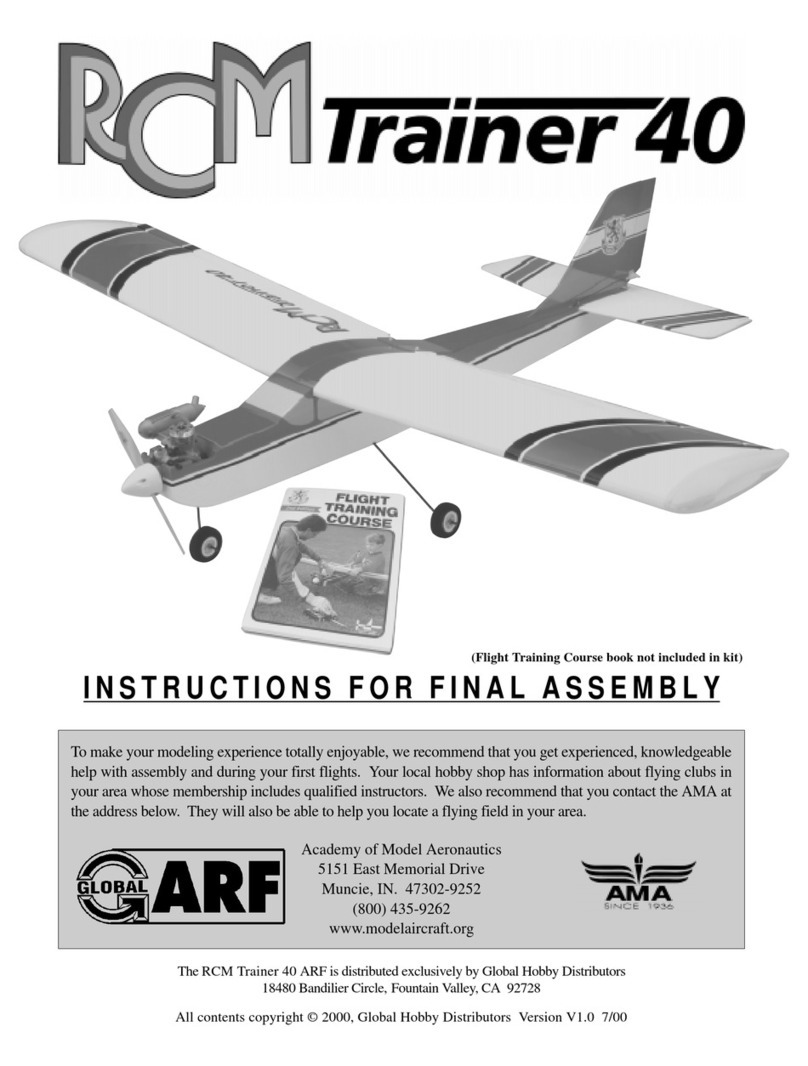
Global Hobby
Global Hobby RCM Trainer 40 User manual
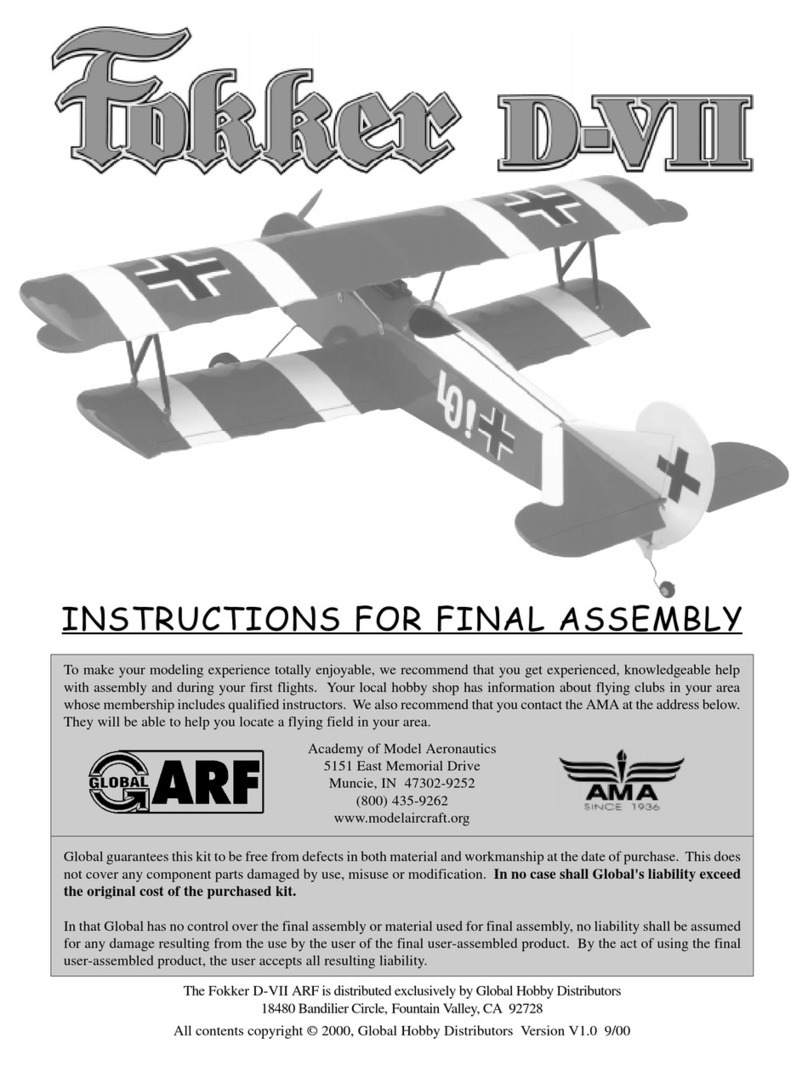
Global Hobby
Global Hobby Fokker D-VII User manual

Global Hobby
Global Hobby Dago Red 4 User manual
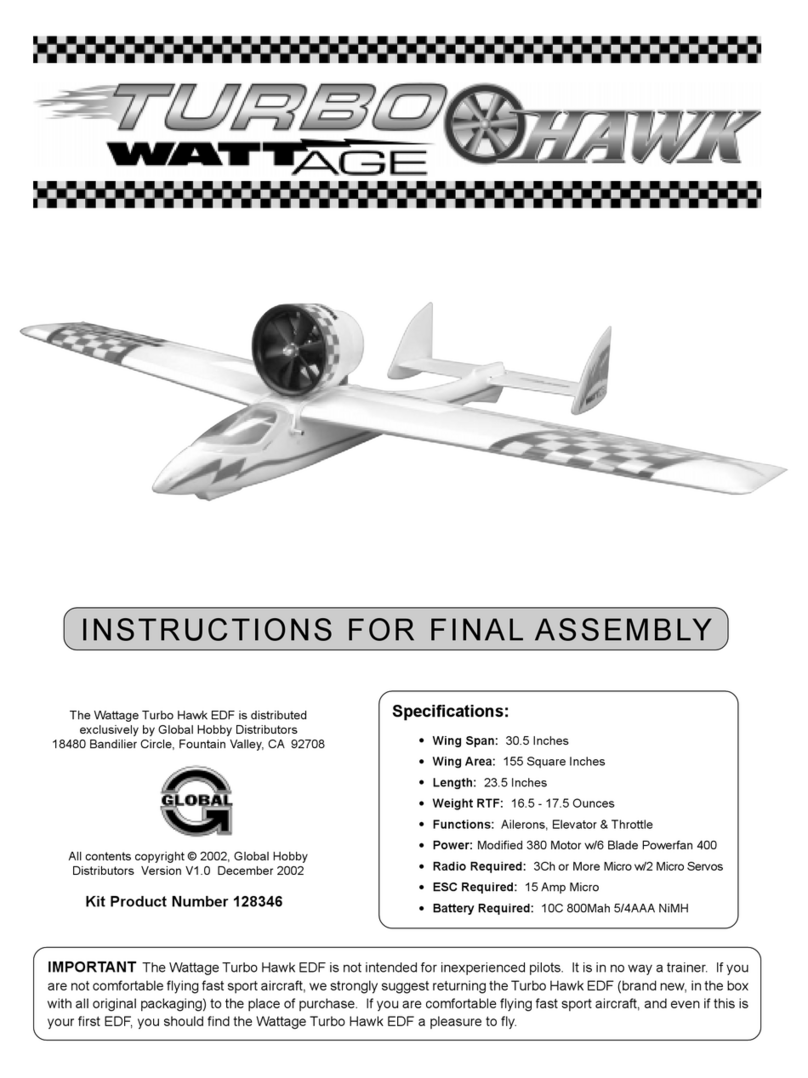
Global Hobby
Global Hobby Wattage Turbo Hawk EDF User manual

Global Hobby
Global Hobby Wattage Sky Wizard User manual
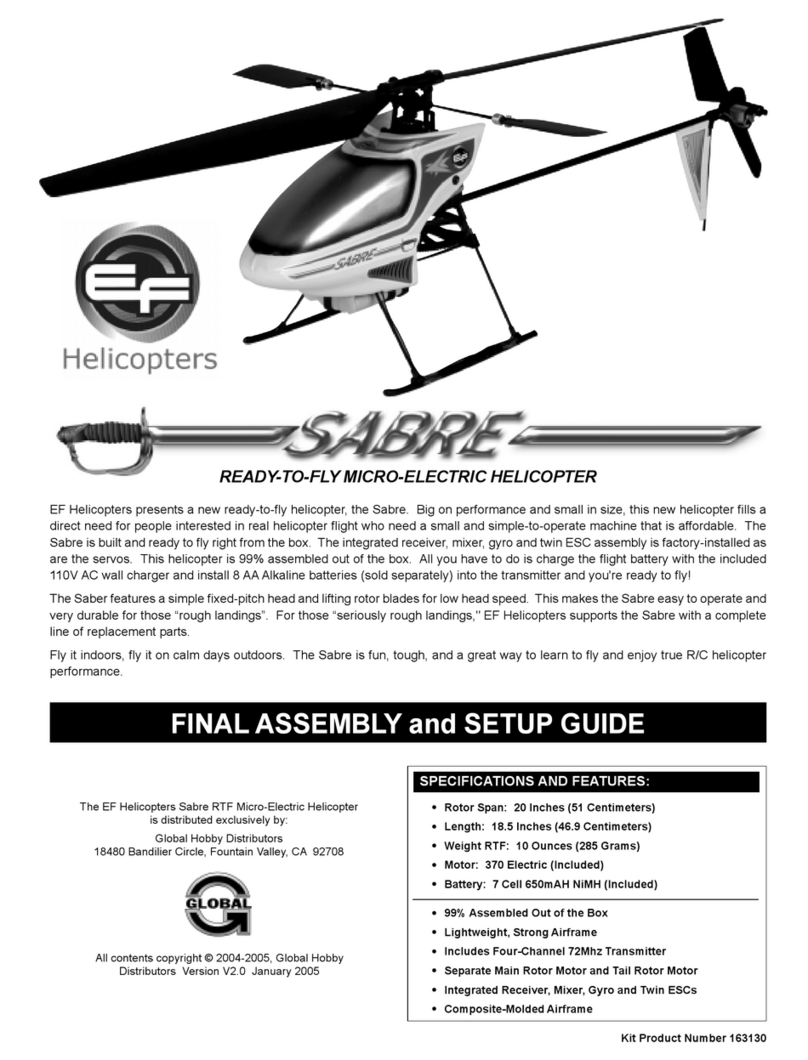
Global Hobby
Global Hobby Sabre User manual
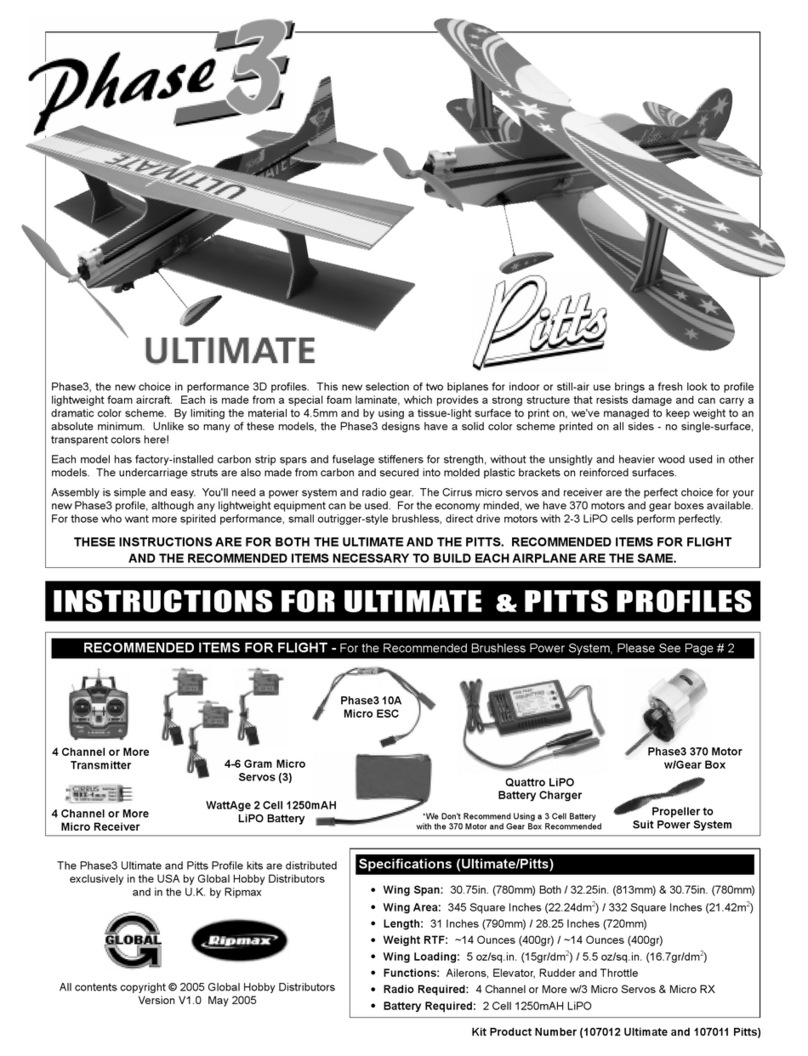
Global Hobby
Global Hobby Phase 3 Ultimate User manual
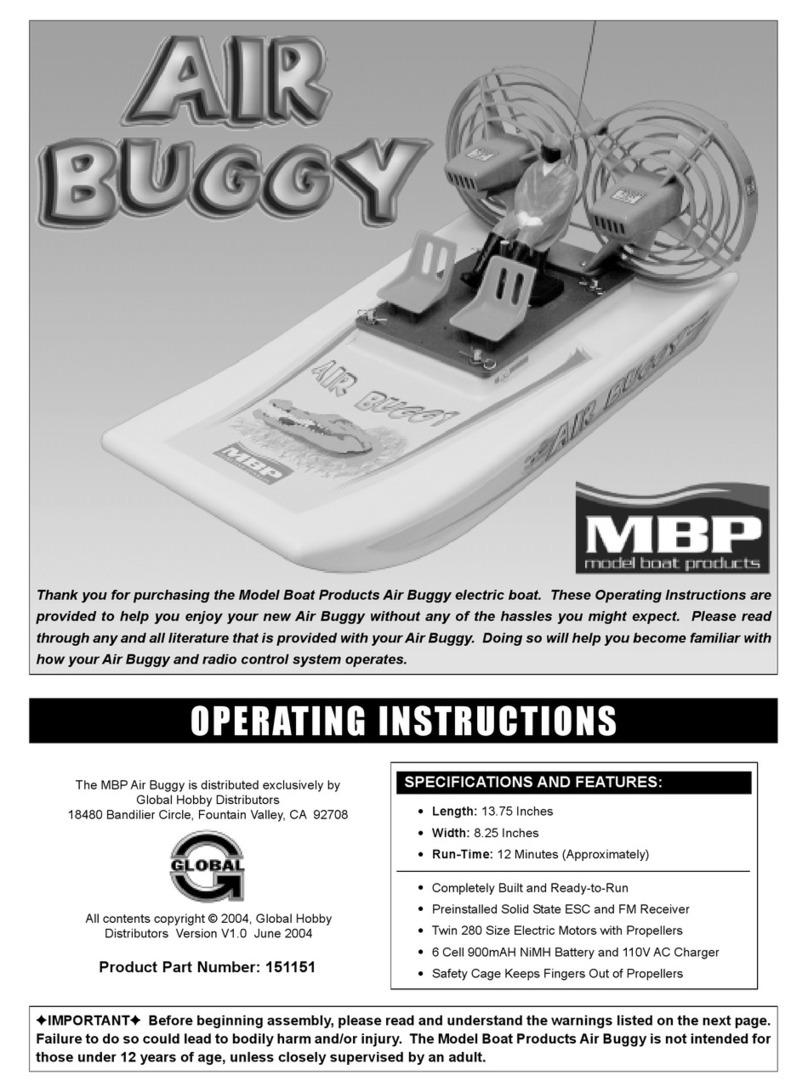
Global Hobby
Global Hobby Air Buggy 151151 User manual
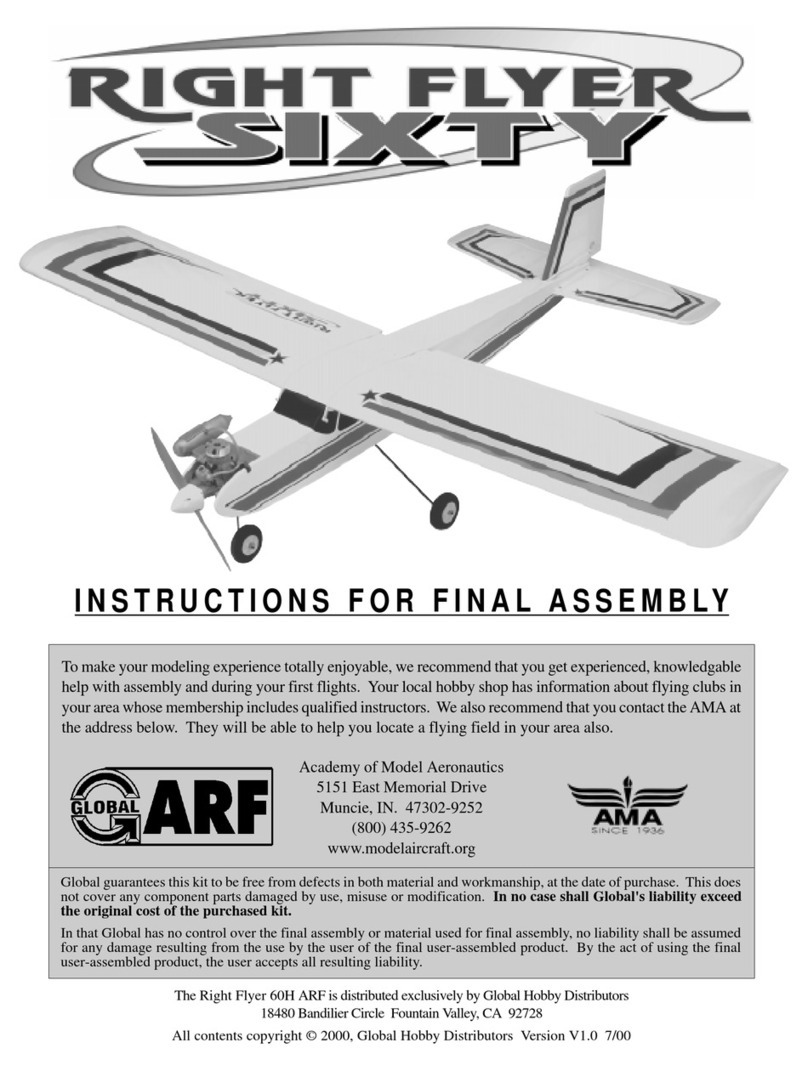
Global Hobby
Global Hobby Right Flyer 60H ARF User manual
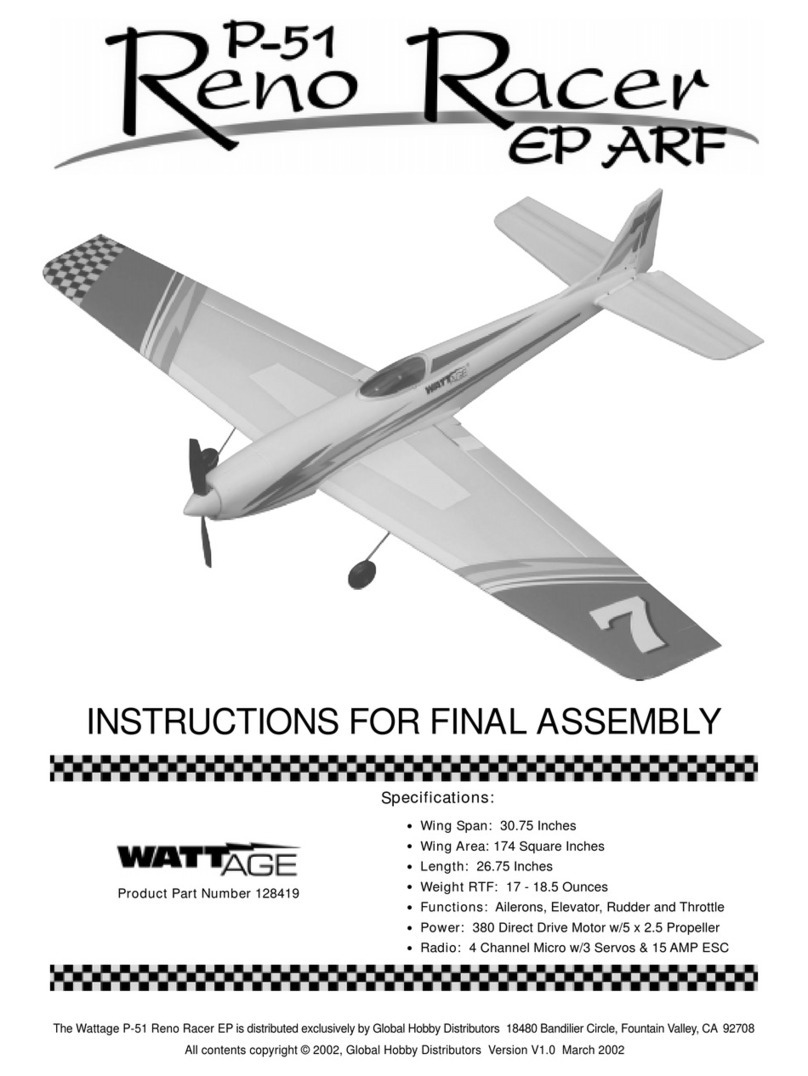
Global Hobby
Global Hobby Wattage P-51 Reno Racer EP User manual
